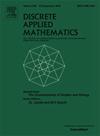论最大阶数为 4 的图的注边着色
IF 1
3区 数学
Q3 MATHEMATICS, APPLIED
引用次数: 0
摘要
如果对于任意两条不同的边 e1 和 e2,如果 e1 和 e2 在 G 中的距离为 2 或在一个公共三角形中,则它们的颜色是不同的,则图 G 的边着色是注入式的。本文将证明,如果 G 是 Δ(G)=4 的图,且最大平均度小于 52(即 135,3613),则 χinj′(G)≤6(即 7,8)。本文章由计算机程序翻译,如有差异,请以英文原文为准。
On injective edge-coloring of graphs with maximum degree 4
An edge-coloring of a graph is injective if for any two distinct edges and , the colors of and are distinct if they are at distance 2 in or in a common triangle. The injective chromatic index of , , is the minimum number of colors needed for an injective edge-coloring of . In this paper, we prove that if is graph with and maximum average degree is less than (resp. , ), then (resp. 7, 8).
求助全文
通过发布文献求助,成功后即可免费获取论文全文。
去求助
来源期刊

Discrete Applied Mathematics
数学-应用数学
CiteScore
2.30
自引率
9.10%
发文量
422
审稿时长
4.5 months
期刊介绍:
The aim of Discrete Applied Mathematics is to bring together research papers in different areas of algorithmic and applicable discrete mathematics as well as applications of combinatorial mathematics to informatics and various areas of science and technology. Contributions presented to the journal can be research papers, short notes, surveys, and possibly research problems. The "Communications" section will be devoted to the fastest possible publication of recent research results that are checked and recommended for publication by a member of the Editorial Board. The journal will also publish a limited number of book announcements as well as proceedings of conferences. These proceedings will be fully refereed and adhere to the normal standards of the journal.
Potential authors are advised to view the journal and the open calls-for-papers of special issues before submitting their manuscripts. Only high-quality, original work that is within the scope of the journal or the targeted special issue will be considered.
 求助内容:
求助内容: 应助结果提醒方式:
应助结果提醒方式:


